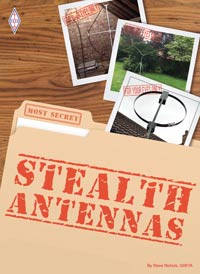 Remember when all ships had real radio operators? If you do you'll know that the ops had to maintain "silent periods" when they wouldn't transmit, instead listening for distress calls on 500kHz and 2182kHz. For this they had a special radio room clock with sectors marked on it.
Remember when all ships had real radio operators? If you do you'll know that the ops had to maintain "silent periods" when they wouldn't transmit, instead listening for distress calls on 500kHz and 2182kHz. For this they had a special radio room clock with sectors marked on it.After the loss of the Titanic, the radio frequency of 500 kHz became an international calling and distress frequency for Morse code maritime communication. For most of its history, the international distress frequency was referred to by its equivalent wavelength, 600 meters, or, using the earlier frequency unit name, 500 kilocycles [per second] or 500 kc.
2182kHz was added later and transmissions on 2182 kHz commonly use single-sideband modulation (SSB) (upper sideband only). However, amplitude modulation (AM) was often used in some parts of the world.
Maritime coastal stations used to maintain 24 hour watches on these frequencies, staffed by highly-skilled radio operators.
As a reminder, a ship's radio room clock would have the 500kHz silence periods marked by shading the sectors between h+15 to h+18 and h+45 to h+48 in RED. Similar sectors between h+00 to H+03 and h+30 to h+33 were marked in GREEN, which is the corresponding silence period for 2182 kHz.
Anyone breaking the rules would soon hear "QRT SP" in Morse Code, meaning "STOP SENDING - SILENT PERIOD!"
 I've always wanted to have one of these clocks for my own shack, but couldn't find one. So … I decided to make one. I spent two days with a graphics program recreating a radio room clock from the Winthrop Clock Company of Boston, Ma., USA. It wasn't easy, but I then took the finished result, printed it and pulled apart a quartz clock that I bought for the job and installed it - what a lot of work!
I've always wanted to have one of these clocks for my own shack, but couldn't find one. So … I decided to make one. I spent two days with a graphics program recreating a radio room clock from the Winthrop Clock Company of Boston, Ma., USA. It wasn't easy, but I then took the finished result, printed it and pulled apart a quartz clock that I bought for the job and installed it - what a lot of work!
The end result is shown in the photograph above and creates quite a lot of attention in my shack. It also keeps time really well too!
There is even The Radio Maritime Day each April where you have to obey the silent periods, so it comes in useful
Anyway, after all that work it seemed a shame to waste the artwork. I then found that I could upload it to a company called CafePress, letting people buy their own clock. While I was there I also designed some T-shirts, mugs, mouse mats and other goodies.
These products, including a reproduction radio room clock, let you relive those bygone, halcyon days when "sparks" ruled the maritime airwaves. So your shack can now look like a ship's radio room!
Go to https://www.cafepress.com/theradioroom – you can select the currency you wish to pay with.
I have one of the new Cafe Press clocks - it is about 10 inches in diameter and very striking. It is quartz powered so keeps good time and the tick isn't too loud either. Looks very nice on the wall and not too expensive either.
But remember QRT SP!









I have one of those clock reproductions. Works fine. The real thing, now an antique, can go for $1000 and higher. 73 Dick
ReplyDeleteThanks Dick - probably keeps better time than the old clockwork ones too! 73 Steve G0KYA
ReplyDeleteOn a related topic you should take a look at a book describing the English government's search for a way to determine longitude at sea, which required a chronometer that would remain accurate under those conditions:
ReplyDeletehttp://www.amazon.com/Longitude-Genius-Greatest-Scientific-Problem/dp/0140258795
A fascinating read.
Yes, the great John Harrison - there was a brilliant TV adaptation on the BBC some time ago called "Longitude".
ReplyDeleteYou can still get it on DVD - see:
http://www.amazon.co.uk/gp/product/B000L42N96?ie=UTF8&tag=cringlefordsc-21&linkCode=as2&camp=1634&creative=6738&creativeASIN=B000L42N96
Aha one of my favourite books of the last 10 years - "Longitude". In Oz I was a CB guy on SSB for 3 glorious years and an SWL for the same time 1997 to 2000. It was a sad day when my 5/8 vertical was taken down and the wire rolled up, the radios put "in storage" with a friend (I expect to never see them again BTW). But how your story got to me, was it reminded me how habitually in the Central West of NSW I used to tune my FRG7700 to 2.182 USB whnever I was reading a book or not particularly searching for anying, just in case I heard something that was important and maybe even I could use the phone to alert the right people. In those three years I can remember earing a thing, but it didn't stop me listening! all the best, Scotty
ReplyDeleteI hope you take part in the annual MRD events :-)
ReplyDelete73 de OH8XAT (ex DRKF)
and remember! QRX3 SP AS
Bit disappointing that it wasn't modeled after a good old British Smiths Astral radio room clock! :-)
ReplyDeleteIf you can get me the face off one I'll do it! Or at least a good scan of one.
DeleteBest I can suggest is you pinch one off the 'net :-)
ReplyDeletehttp://www.sellingantiques.co.uk/261219/smiths-red-green-segment-radio-room-clock/
Hi Steve , fascinating blog , I am in a similar position regarding clock face design , but with a bit of a twist .. i am constructing this car ,
ReplyDeletehttp://www.rodsnsods.co.uk/forum/garage/medusa-206057
and for the dash vintage rev counter i am using this old radio room clock ...
http://i32.photobucket.com/albums/d44/ivanhoew/medusa/IMG_3165_zpsmklngfwj.jpg
http://i32.photobucket.com/albums/d44/ivanhoew/medusa/IMG_3164_zpsyh1id3nn.jpg
I want to make get a dial printed with rpm on it , basically 0to 6k going from 8pm to 4 pm. can you point me in the right direction as to how you did yours ?
regards
robert.
Hi Robert,
DeleteJust did a double take there - I thought I had seen TWO Jaguar straight six engines, then I realised I had! I started by scanning a clock face and then went to work with Photoshop. It took me two days, but I got the result I wanted. The Photoshop file had nearly 40 layers with everything separate so that everything was independent. Best bet is to find a tame graphic designer unless you are familiar with Photoshop.
wow 2 days !! , i will cast about for a friend with ps experience , hopefully mine will be a bit simpler with just a white background and black numbers . Thank you for the pointers .:)
ReplyDeleteregards
robert.
I repair clocks and have in a Chelsea clock with only the red markings. It is labeled US Maritime Commission. The clock has two hour hands that can be set for two time zones. Radio clock?
ReplyDeleteYes. The additional hour hand was set to GMT (the time at the Prime Meridian which passes through Greenwich, England --hence, "Greenwich Mean Time" or "GMT"), now known as UTC ("Coordinated Universal Time") which is synchronized via atomic cesium clocks at the U.S. Naval Observatory and the time signals thereof transmitted by various radio stations of the National Institute of Standards and Technology on 2.5, 5. 10 and 15 MHz. Other nations likewise have official radio frequencies dedicated 24/7 to time signals. Aviators, mariners and radio operators keep time according to GMT/UTC so that all are "on the same time." Every so often, the cesium atomic clocks get ahead of the universe's time so a "leap second" -- literally a 61st second -- is inserted into the 59th minute of the 23rd hour UTC in order to synchronize clock time with universal time.
DeleteReading around on this fascinating subject, it seems practical use of the the 500KHz band starts after 1908 and was over before the 1950s (though its final abandonment only came in 1999 when coastguard monitoring ceased).
ReplyDeleteFrom 1932, 1650 kHz began to be used as the main international distress frequency, and though not documented, it would have been odd to introduce this and not have a silent monitoring period for it.
2182KHz started to be used in the 1950s, ending in 2013 when the US Coast Guard stopped monotoring it, as GMDSS has supplanted it.
These dates suggest the red-sector only clock is likely to be early - after 1908 (prob >1912) and likely before 1932 when 1650 kHz began to be used, and certainly before ~1950.
HTHs!
I qualified as a Marine Radio Officer in 1968 and sailed as an RO for BP tankers until the early 70s. I can assure you that 500 kHz was the international distress frequency then and until around the 90s. Silence periods were scrupulously observed because, especially in northern Europe waters, 500 kHz was very heavily trafficked because it was also the frequency used to call up coast stations and other vessels. The general noise of the traffic would drown any weak distress signals, which could also potentially have come from the hand-cranked emergency transmitter carried in a lifeboat. The silence periods were also useful to make the autoalarm signals more audible. As you probably know, all vessels were obliged to maintain a 24 hour watch on 500 kHz so that on a vessel only carrying a single radio officer, known as an H8 vessel, the autoalarm was set for use when the sparky was off watch.
DeleteThis brings back a few memories. I was a USCG Radioman at NMO (Honolulu). Work seven SOS or XXX cases from 1977-83 and while on USCGC Munro (NGDF) one XXX that ended up being a three day rescue. I think the most significant was the MS Princendam (PJTA) SOS which happened in Oct 1980. They still do a survivor's reunion every Oct.
ReplyDeleteThe red marks around the outside were for the 12 four second ‘dahs’ designed to trigger other ships automatic alarm system. These were sent before an SOS.
ReplyDeleteHave a listen to episode 27 & 28 of the ‘Dit Dit Dot’ podcast
Most of the decent size ships today still have those clock faces on bridge clocks...at least in the finnish cargo ships they do. I knew what the red areas were (seen old movies) but the green ones were a mystery. But literally no officer I have ever asked has known the pourpose of them.
ReplyDeleteJust curious. Are merchant ships today still required to have a RADIO ROOM CLOCK? I cannot find any regulation for this particular issue.
ReplyDeleteI don't think ships even have a radio room nowadays, so no, no clocks!
ReplyDeleteI work on Afra max oil tankers and we still have such clocks onboard, with no radio rooms but a small section with compact and latest technology based radio systems. To be honest, such old equipment like clock are often ignored and just considered to provide an essence about how complex the life used to be on ships, and how the small things mattered and were used to their advantage.
ReplyDeleteAlso, I appreciate the effort you made in making people aware about the least known fact of the radio clock. Keep it up!
Ships still have the Radio Room Clocks. The purpose is that when the GMDSS officer is writing the log in a distress situation, he only has to look up to know the time in UTC.
Delete